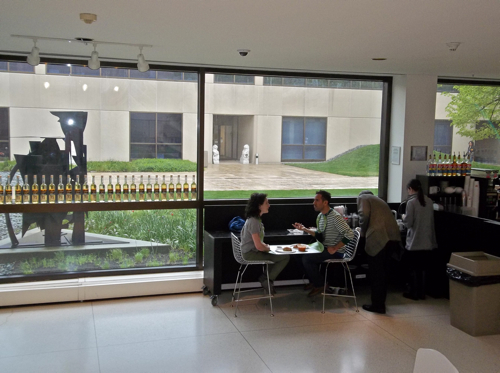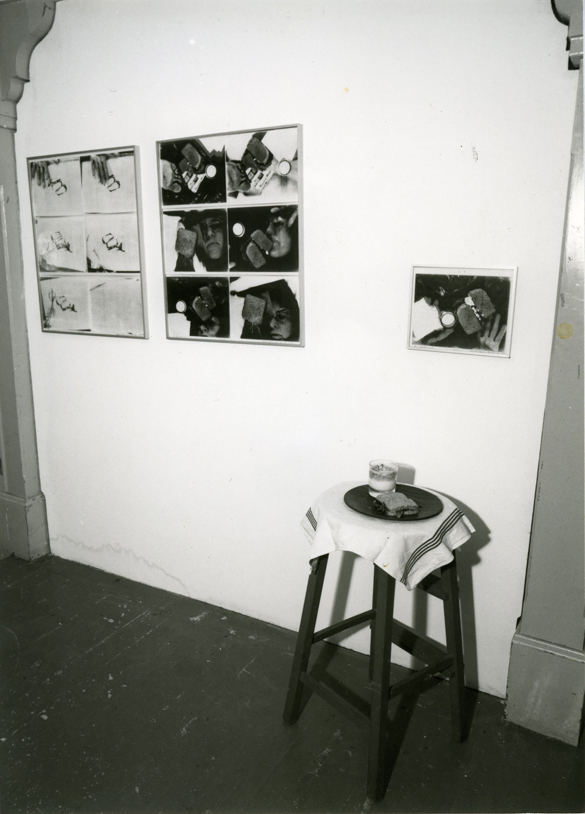May 2012 Archives

By Diego Arispe-Bazan
MA'11 University of Chicago and Smart curatorial intern
At a salon hosted by threewalls a few weeks ago, with a group of artists, sociologists, and other practitioners working on various social engagement projects (including Martha Bayne of Soup and Bread and the Smart Museum's own Stephanie Smith), the conversation turned for a moment to the possibility of productive failure. Martha shared a story. Once, at a Soup and Bread event, she was chastised by a visitor for the lack of vegan options, something she had no control over, as meals brought for each iteration are donated, and their contents are up to each cook. It seemed draconian on the one hand to demand that cooks produce vegan soups; it seemed draconian, on the other, to deny vegans the ability to participate. Not providing vegan soups, a type of institutional failure, is an example of the inability to accommodate, to welcome the guest or viewer into the situation via our sensory or aesthetic offerings. However, these conflicts provide a gateway into exploring a crucial aspect of hospitality: failure to lunch.
I considered Jean Anthelme Brillat-Savarin's famous phrase, currently displayed in the Feast exhibition: "to invite people to dine with us is to make ourselves responsible for their well-being for as long as they are under our roofs." Hosting, therefore, is not purely about providing good food, but rather providing a good meal. When we unwittingly serve our guests a dish they find atrocious, we, as good hosts, don't simply give up. We don't blame them for their lack of taste. We don't have a hearty chuckle and keep eating as if nothing was the matter. Instead, as obliging hosts, we redouble our efforts: we offer something else, ask the guest to explain her opinion. Hopefully, we laugh together. Blatant failure, forcing a new exchange in order to overcome the impasse, leaves both guest and host with a new set of relational tools to deal with disappointment, discomfort, etc. in their social repertoire.
Yet there is still an insistence, and expectation of success. At threewalls, social workers, anthropologists and sociologists involved in participatory projects wondered: "will the communities we choose to work in respond positively--will they eat what we're serving?" How can the success of projects like Occupy Yr. Home or even the International Dinner Party, be measured?
The National Bitter Melon Council, for example, has come up against this question repeatedly. In their manual, they preemptively warn us about the bitter taste of the bitter melon fruit, a symbol and material in much of their work. In one of the texts in the NBMC's Better Living Through Bitter Melon Manual, Louisa McCall, Program Director of the LEF Foundation (2000-2008), poignantly remarks: "to what extent did we need aesthetic outcomes from art projects?" It seems to me that there is inevitably an aesthetic outcome, just as every meal has an olfactory and gustatory outcome. And they are comparable: they can be imperceptible, subtle, they can dissipate quickly or spread wildly in multiple directions. And of course, they can be colossal failures.
Ultimately, the gesture is key. We prepare our dream meal just as orchestrating participatory pieces in new communities -- we do so at the peril of our confidence. But in the common adversity of the failure, a shared, learned practice of generosity emerges, a conversation between hosts and guests, artists and audience, impossible without the gesture's extension.
Theaster Gates shows how creating intentional space for community can drive artistic discourse, through the construction, layout, and use of the Dorchester Projects house, home to the Soul Food Pavilion dinners.
Michael Rakowitz talks about serving dinner on flatware looted from the palace of Saddam Hussein. Paper replicas of these plates are being used by the Enemy Kitchen food truck, now serving Iraqi cuisine on the streets of Chicago.
If you didn't have a chance to try Enemy Kitchen's wares at the Feast opening, catch the truck in action by following the project on Twitter.
This past weekend at the Symposium, and throughout the run of Feast, people have been getting a taste of a particular tradition of Serbian hospitality: a spoonful of a sweet strawberry preserve called slatko, as a part of Ana Prvacki's Greeting Committee project.
Here, Prvacki reveals the family history behind her artistic interest in this practice.
Feast artists Marina Abramović, Sonja Alhäuser, Mary Ellen Carroll, Theaster Gates, Mella Jaarsma, Alison Knowles, Suzanne Lacy, Lee Mingwei, Laura Letinsky, Tom Marioni, Ana Prvacki, and Michael Rakowitz reflect on hospitality.

By Emily Capper
University of Chicago PhD candidate and Smart curatorial intern
Feast has been open for more than a couple of months, yet the parts are still moving. An exhibition of more traditional artworks would have been entirely settled long ago. It's of course true that paintings and sculptures change something of their appearance and meaning when installed under particular physical and discursive conditions -- against a brightly colored wall or next to an explanatory label, for example. But with Feast, we're involved in a qualitatively different situation. Several works in the show simply did not exist in physical form until now. We have been actively generating these forms in literal collaboration with artists -- and they're not finished yet!
Take, for example, Alison Knowles' Identical Lunch. Although dated 1969 according to museum convention, the work has no clear-cut origin, and has changed form -- and identity -- over time. Indeed, that's the chief philosophical point of the Lunch: that no object is identical to itself in human experience. Knowles tells us that the project began unconsciously, as just something she did (and not yet "art"). Throughout the late sixties she visited the same neighborhood luncheonette at noon and ordered the same meal (the best thing on the menu, she recalls). With her friend, the composer Philip Corner, Knowles came to think of the lunch as a semi-formal performance, and so she published a score, which reads:
"The Identical Lunch: a tunafish sandwich on wheat toast with lettuce and butter, no mayo, and a large glass of buttermilk or a cup of soup was and is eaten many days of each week at the same place and at about the same time."
Like a musical score, this one inspired and guided countless performances of the lunch. Her friends participated, recording their diverse experiences of the "same" meal through a network of texts and snapshots.
Such creative "documents" are easy enough to present in a museum context, and Feast includes wonderful examples of this material, like a suite of screenprint portraits Knowles made of her friends eating the lunch. But early on in the curatorial process we sensed the limitation of this approach. It places Knowles' project securely in the past, when in fact as an artist she's committed to the possibilities of the present.
How, we wondered, could we be faithful to this aspect of the work? How could we make contingency palpable in the finite and necessarily regulated space of the gallery? Sarah Mendelsohn and I brought these questions to Alison herself in a series of fascinating conversations. Together, we decided to revisit an installation form pictured in an anonymous snapshot from the 1970s (above).
We placed a wooden counter stool in the gallery with a simple cloth napkin and plate on top. Several times a week, our Security Supervisor Paul Bryan fills that plate with a real glass of buttermilk and a tunafish sandwich prepared fresh by Foodism, a local caterer, according to the specifications of Alison's score. Several days later, when the sandwich and buttermilk are just on the verge of going bad, Paul replaces them again. Through this ongoing ritual, which depends on so many people, visibly volatile food enters the gallery and provokes visceral reactions that range from hunger to disgust (depending on the visitor's taste).
Of course, the viewer can't eat this sandwich, which is secured under a plastic cake cover. But just outside the gallery she's invited to perform the score -- even daily, if she wishes. The Museum café stocks the Identical Lunch made by Foodism for purchase, like any other item on the menu. Along with the tunafish sandwich, you can choose a glass of buttermilk or a cup of the soup of the day.
This Saturday (May 5) we are all invited to ingest the Identical Lunch in yet another form. As part of the Of Hospitality symposium, Alison will be directing student volunteers (including me and Sarah) to perform her new Identical Lunch Symphony. Alison based the symphony's score on her friend and Fluxus colleague George Maciunus' 1971 interpretation of her 1969 score, which he set down in a letter: "Dear Alison, Here is my idea for the--identical lunch--Put tuna fish, wheat toast, lettuce, butter, soup or buttermilk--all into blender--blend till all is smooth--drink it. Best regards, George."
Alison's Symphony further processes Maciunus' idea for the lunch through the idiom of formal concert music. The student volunteers will be the orchestra and our personal blenders will be our instruments. While mass-produced, no two blenders sound identical. Inspired by the unpredictable range of sounds at her disposal, Alison will assume the role of conductor. She'll direct each of us to variously and rhythmically crush, mix, and puree the sandwich with a quart of buttermilk "till all is smooth." We will then offer it in cups to the audience. When Alison first told us about her plans for the symphony, I couldn't help but pucker my lips in almost instinctual disgust.
She assured us, though, that blending the lunch in fact transforms it into "a wonderful cold fish soup." I cannot wait to test this theory in experience on Saturday.